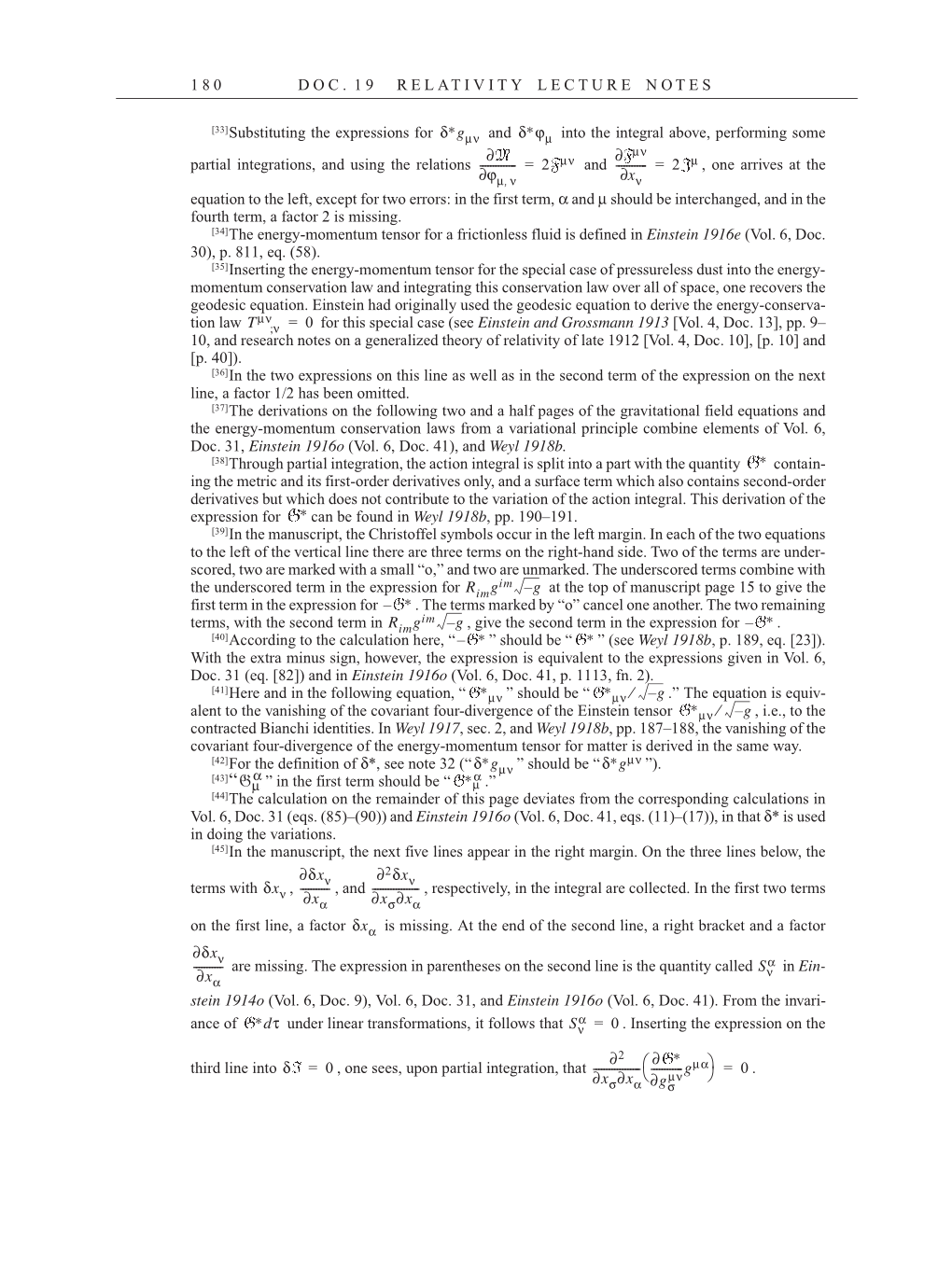1 8 0 D O C . 1 9 R E L AT I V I T Y L E C T U R E N O T E S
[33]Substituting the expressions for and into the integral above, performing some
partial integrations, and using the relations and , one arrives at the
equation to the left, except for two errors: in the first term, α and μ should be interchanged, and in the
fourth term, a factor 2 is missing.
[34]The energy-momentum tensor for a frictionless fluid is defined in Einstein 1916e (Vol. 6, Doc.
30), p. 811, eq. (58).
[35]Inserting the energy-momentum tensor for the special case of pressureless dust into the energy-
momentum conservation law and integrating this conservation law over all of space, one recovers the
geodesic equation. Einstein had originally used the geodesic equation to derive the energy-conserva-
tion law for this special case (see Einstein and Grossmann 1913 [Vol. 4, Doc. 13], pp. 9–
10, and research notes on a generalized theory of relativity of late 1912 [Vol. 4, Doc. 10], [p. 10] and
[p. 40]).
[36]In the two expressions on this line as well as in the second term of the expression on the next
line, a factor 1/2 has been omitted.
[37]The derivations on the following two and a half pages of the gravitational field equations and
the energy-momentum conservation laws from a variational principle combine elements of Vol. 6,
Doc. 31, Einstein 1916o (Vol. 6, Doc. 41), and Weyl 1918b.
[38]Through partial integration, the action integral is split into a part with the quantity contain-
ing the metric and its first-order derivatives only, and a surface term which also contains second-order
derivatives but which does not contribute to the variation of the action integral. This derivation of the
expression for can be found in Weyl 1918b, pp. 190–191.
[39]In the manuscript, the Christoffel symbols occur in the left margin. In each of the two equations
to the left of the vertical line there are three terms on the right-hand side. Two of the terms are under-
scored, two are marked with a small “o,” and two are unmarked. The underscored terms combine with
the underscored term in the expression for at the top of manuscript page 15 to give the
first term in the expression for . The terms marked by “o” cancel one another. The two remaining
terms, with the second term in , give the second term in the expression for .
[40]According to the calculation here, “ ” should be “ ” (see Weyl 1918b, p. 189, eq. [23]).
With the extra minus sign, however, the expression is equivalent to the expressions given in Vol. 6,
Doc. 31 (eq. [82]) and in Einstein 1916o (Vol. 6, Doc. 41, p. 1113, fn. 2).
[41]Here and in the following equation, “ ” should be “ .” The equation is equiv-
alent to the vanishing of the covariant four-divergence of the Einstein tensor , i.e., to the
contracted Bianchi identities. In Weyl 1917, sec. 2, and Weyl 1918b, pp. 187–188, the vanishing of the
covariant four-divergence of the energy-momentum tensor for matter is derived in the same way.
[42]For the definition of δ*, see note 32 (“ ” should be “ ”).
[43]“Gμ
” in the first term should be “ .”
[44]The calculation on the remainder of this page deviates from the corresponding calculations in
Vol. 6, Doc. 31 (eqs. (85)–(90)) and Einstein 1916o (Vol. 6, Doc. 41, eqs. (11)–(17)), in that δ* is used
in doing the variations.
[45]In the manuscript, the next five lines appear in the right margin. On the three lines below, the
terms with , , and , respectively, in the integral are collected. In the first two terms
on the first line, a factor is missing. At the end of the second line, a right bracket and a factor
are missing. The expression in parentheses on the second line is the quantity called in Ein-
stein 1914o (Vol. 6, Doc. 9), Vol. 6, Doc. 31, and Einstein 1916o (Vol. 6, Doc. 41). From the invari-
ance of under linear transformations, it follows that . Inserting the expression on the
third line into , one sees, upon partial integration, that .
δ∗gμν δ∗ϕμ
∂
ν
∂ϕμ,
------------- - 2 μν =
μν
∂
∂xν
----------- - 2 μ =
Tμν;ν 0 =
∗
∗
Rimgim –g
∗
–
Rimgim –g
∗
–
∗
–
∗
∗μν ∗μν
–g ⁄
∗μν
–g ⁄
δ∗gμν δ∗gμν
α ∗μ
α
δxν
∂δxν
∂xα
-----------
∂2δxν
∂xσ∂xα
------------------
δxα
∂δxν
∂xα
----------- Sν α
∗dτ
Sν
α
0 =
δ 0 =
∂2
∂xσ∂xαè
------------------æ
∂
∗
∂gσ μν
----------- -gμαø
ö
0 =
